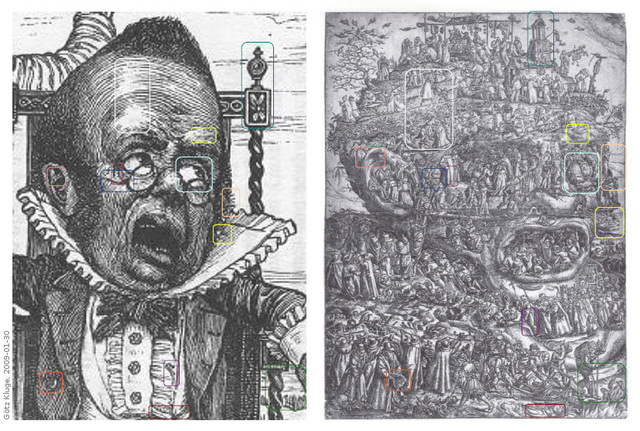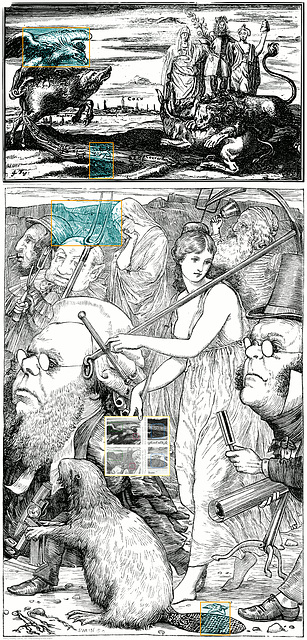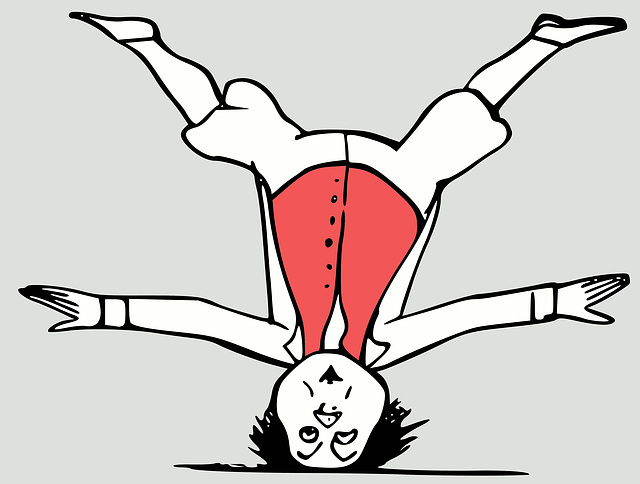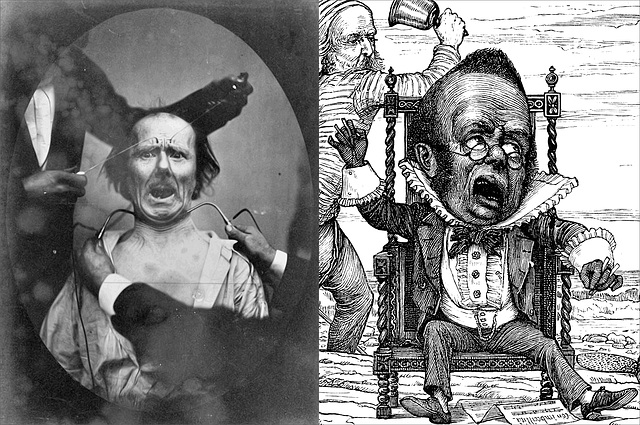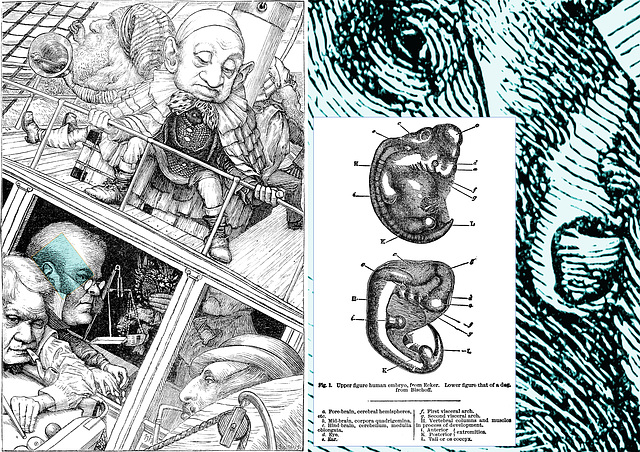
The Banker
Folder: The Hunting of the Snark
26 Jun 2011
3 comments
Nosemorph
Slowly and silently.
[start]: a horizontally compressed copy of The Image Breakers (1566-1568) aka Allegory of Iconoclasm , an etching by Marcus Gheeraerts the Elder (British Museum, Dept. of Print and Drawings, 1933.1.1..3, see also Edward Hodnett: Marcus Gheeraerts the Elder , Utrecht 1971, pp. 25-29). I low-pass-filtered some elements which Holiday used to construct the Banker's spectacles and (segment in left image) mirrored the "nose" about a horizontal axis.
[end]: The Banker after his encounter with the Bandersnatch , depicted in a segment of Henry Holiday 's illustration to The Banker's Fate in Lewis Carroll's The Hunting of the Snark (scanned from an 1876 edition of the book)
(Also available here: www.youtube.com/watch?v=06X98w0YvEU&hd=1 )
30 Jan 2009
2 comments
The Bankers Fate
My first comparison related to The Banker (2009). After more than one year I suddenly understood Holiday's nose job:
03 Apr 2010
1 favorite
3 comments
William III, Religion and Liberty, Care and Hope
The color markers in both images show, to which pictorial elements in a 1674 print Henry Holiday alluded in his illustration to Lewis Carroll's The Hunting of the Snark (lower image, 1876) in the chapter The Hunting . The print (upper image by an anonymous artist, redrawn by me) is the orartie van de Professor L. Wolsogen over syndroom en de nytlegging van de felue gadaen ... . The animals in that print are based on illustrations by M. Gheeraerts the Elder to Aesop's Fables. (The print now is located at British Museum, BM Satires 1047, reg.no.: 1868,0808.3286 . A scan of the original print showing more details can be obtained from the museum.)
Holiday alluded to that 1674 image depicting William III as well as the allegorical figures for "religion" and "liberty". He discussed with Dodgson (Carroll) about the possible allegorical depiction of "care and hope". Interestingly, the two female members of the hunting crew also are quite similar to the allegories of "religion" and "liberty" shown in the 1674 print, the conflict between both probably being also conflict for the reverend Dodgson.
I made this image in the year 2010. The little inset with the yellow frame was my first presentation (2009-07-09) of the comparison.
11 Oct 2014
2 favorites
7 comments
He stood on his head till his waistcoat turned red
There was an old man of Port Grigor,
Whose actions were noted for vigour;
He stood on his head till his waistcoat turned red,
That eclectic old man of Port Grigor.
Edward Lear, 1872
(In Lear's original illustration, the waistcoat was white. The printing was B&W only. I added the red color and vectorized the illustration before enlarging it.)
22 Jan 2015
1 favorite
2 comments
The Expression of Emotions
To me, the Bellman 's arm (upper left corner in the right image) always looked strangely rounded. But obviously there are arms like that. It took me a long time (until today) to get the idea that also these two images could be related although I know Duchenne's photo (shown here in mirror view) since a couple of years.
www.evolutionnews.org/2012/05/creepy_ghoulish059671.html
"Creepy," "ghoulish," "not the best science" -- these are a few indisputable descriptions applied (by Wired magazine ) to an experiment Charles Darwin conducted in 1868. He was getting ready to write his book The Expression of the Emotions in Man and Animals and set out to sample reactions from all of 24 human subjects as they responded to and characterized a series of creepy, ghoulish photographs by French physiologist Benjamin Duchenne.
Charles Darwin didn't conduct these weird experiments. Duchenne did.
On the right side you see a detail from Henry Holiday's illustration to the chapter The Banker's Fate in Lewis Carroll's The Hunting of the Snark (1876).
The only known letter exchange between C. L. Dodgson (aka Lewis Carroll) and Charles Darwin was about photos of facial expressions, which Dodgson offered to Darwin (who kindly rejected the offer).
15 Mar 2015
1 comment
Schnarkverschlimmbesserung
·
from www.academia.edu/9964379/Schnarkverschlimmbesserung
[1910]: Illustration by Henry Holiday (illustrator) and Joseph Swain (wood cutter) to the chapter The Banker's Fate in Lewis Carroll's The Hunting of the Snark ("corrected" by Macmillan in 1910)
[1876]: Detail from an illustration by Henry and Swain to the chapter The Banker's Fate in Lewis Carroll's The Hunting of the Snark (1st edition, 1876)
[1856]: Detail (mirror view) from The Bone Player (1856) by William Sidney Mount, now displayed in MFA, Boston.
“Improvement” in German is “Verbesserung”. If things get worse, a “Verschlimmerung” has happened. Jokingly (Germans sometimes can do that) we call “Verschlimmbesserung” what has been made worse after someone tried to improve it. That is what the publisher Macmillan did about 100 years ago. They removed a white spot from the illustration by Henry Holiday (illustrator) and Joseph Swain (wood cutter) to the chapter The Banker's Fate in Lewis Carroll's The Hunting of the Snark (1876). I found this Verschlimmbesserung in a smaller low-quality Snark edition published by Macmillan in 1910.
Perhaps the publisher thought that the white spot was Joseph Swain's mistake. But would Henry Holiday and C. L. Dodgson (Lewis Carroll) have tolerated such a mistake? As these perfectionists wouldn't have accepted any bad craftsmanship, the white spot must have had a purpose:
15 Mar 2015
1 favorite
1 comment
Ear & Embryo
(under work)
Henry Holiday can draw ears. So, if an ear does not look like an well depicted ear, there may be a reason.
18 Apr 2015
1 favorite
1 comment
h10 - The Landing
10000 x 14598
Very large version of www.ipernity.com/doc/goetzkluge/19289465
Jump to top
RSS feed- Latest items - Subscribe to the latest items added to this album
- ipernity © 2007-2025
- Help & Contact
|
Club news
|
About ipernity
|
History |
ipernity Club & Prices |
Guide of good conduct
Donate | Group guidelines | Privacy policy | Terms of use | Statutes | In memoria -
Facebook
Twitter


